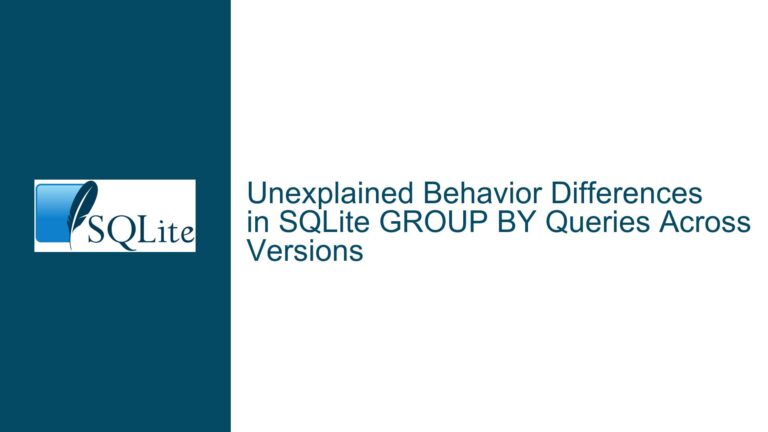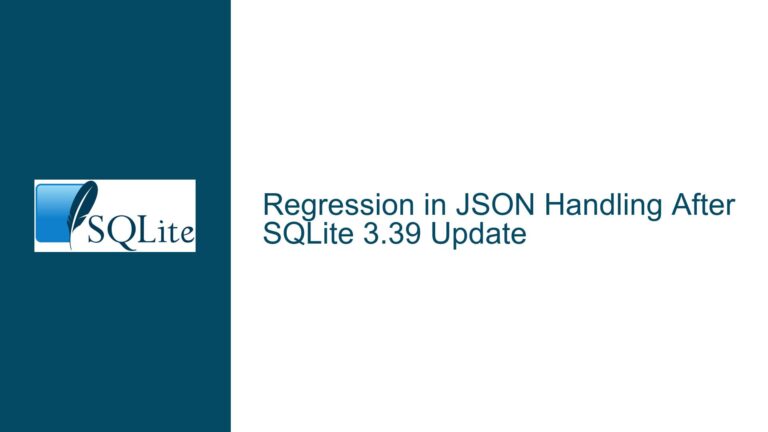Inconsistent Output in SQLite UPSERT with RETURNING Clause
Understanding the Behavior of RETURNING Clause in UPSERT Operations
The core issue revolves around the inconsistent output observed when using the RETURNING clause in conjunction with the INSERT ... ON CONFLICT (UPSERT) operation in SQLite. Specifically, the RETURNING clause works as expected when an INSERT operation is performed, but it fails to return any output when an UPDATE is triggered due to a conflict. This behavior is inconsistent with other databases like PostgreSQL, where the RETURNING clause works seamlessly in both INSERT and UPDATE scenarios during an UPSERT operation.
To fully grasp the issue, it is essential to understand the mechanics of the INSERT ... ON CONFLICT statement, the role of the RETURNING clause, and how SQLite handles conflicts during an UPSERT operation. The INSERT ... ON CONFLICT statement is designed to insert a new row into a table, but if a conflict arises (e.g., due to a unique constraint violation), it allows for an alternative action, such as DO NOTHING or DO UPDATE. The RETURNING clause, on the other hand, is used to return the values of the inserted or updated row(s) after the operation is completed.
In the provided examples, the first INSERT operation successfully inserts a new row and returns the inserted values using the RETURNING clause. However, when a conflict occurs and the DO UPDATE action is triggered, the RETURNING clause does not produce any output. This inconsistency raises questions about whether this behavior is by design, undocumented, or a potential bug in SQLite.
Exploring the Role of the excluded Pseudo-Table in UPSERT Operations
The excluded pseudo-table plays a crucial role in UPSERT operations, particularly when the DO UPDATE action is specified. The excluded pseudo-table contains the values that were attempted to be inserted but were excluded due to a conflict. These values can be referenced in the DO UPDATE clause to update the existing row with the new values.
For example, in the statement INSERT INTO foo VALUES ('name1', 1) ON CONFLICT(name) DO UPDATE SET amount=excluded.amount RETURNING *;, the excluded.amount refers to the value 1 that was attempted to be inserted. The DO UPDATE action updates the amount column of the existing row with this value. However, despite the successful update, the RETURNING clause does not return the updated row, leading to the observed inconsistency.
The excluded pseudo-table is a powerful feature that allows for precise control over the values used in the DO UPDATE action. However, its interaction with the RETURNING clause appears to be problematic in SQLite, as the RETURNING clause does not seem to recognize the updated row as part of its output.
Diagnosing the Inconsistency Between SQLite and PostgreSQL Behavior
The inconsistency between SQLite and PostgreSQL in handling the RETURNING clause during UPSERT operations is particularly noteworthy. In PostgreSQL, the RETURNING clause works as expected in both INSERT and UPDATE scenarios during an UPSERT operation. For example, when a conflict occurs and the DO UPDATE action is triggered, PostgreSQL returns the updated row using the RETURNING clause.
This discrepancy suggests that the behavior observed in SQLite may not be intentional but rather a limitation or a bug. The fact that PostgreSQL handles this scenario correctly indicates that it is possible for the RETURNING clause to work seamlessly in both INSERT and UPDATE scenarios during an UPSERT operation. This raises the question of whether SQLite’s implementation of the RETURNING clause in UPSERT operations is incomplete or if there are underlying technical constraints that prevent it from functioning as expected.
Possible Causes of the Inconsistent Output in SQLite UPSERT Operations
1. Design Limitation in SQLite’s RETURNING Clause Implementation
One possible cause of the inconsistent output is that SQLite’s implementation of the RETURNING clause is designed to work only with INSERT operations and not with UPDATE operations triggered by a conflict. This could be a deliberate design choice, possibly due to the complexity of handling the RETURNING clause in the context of an UPDATE operation during an UPSERT.
In this scenario, the RETURNING clause may not have access to the necessary information to return the updated row, as the UPDATE operation is treated as a separate action from the INSERT operation. This limitation could be rooted in the way SQLite processes the INSERT ... ON CONFLICT statement internally, where the UPDATE action is handled differently from the INSERT action.
2. Undocumented Behavior or Bug in SQLite
Another possible cause is that the inconsistent output is the result of an undocumented behavior or a bug in SQLite. The documentation for the RETURNING clause does not explicitly state that it should only work with INSERT operations and not with UPDATE operations during an UPSERT. Therefore, the observed behavior could be an unintended side effect of the implementation.
If this is the case, it would be considered a bug, and the expected behavior would be for the RETURNING clause to return the updated row when an UPDATE is triggered by a conflict. This would align with the behavior observed in PostgreSQL and other databases that support the RETURNING clause in UPSERT operations.
3. Technical Constraints in SQLite’s Architecture
SQLite is a lightweight, embedded database designed for simplicity and efficiency. As such, it may have certain technical constraints that prevent it from fully supporting the RETURNING clause in the context of an UPDATE operation during an UPSERT. For example, SQLite’s architecture may not allow for the necessary information to be passed back to the RETURNING clause after an UPDATE operation is performed.
This could be due to the way SQLite handles conflicts and updates internally, where the UPDATE operation is treated as a separate transaction from the INSERT operation. In such a scenario, the RETURNING clause may not have access to the updated row’s values, leading to the observed inconsistency.
Troubleshooting Steps, Solutions & Fixes for the Inconsistent Output Issue
1. Verifying SQLite Version and Documentation
The first step in troubleshooting the inconsistent output issue is to verify the version of SQLite being used and review the official documentation for any updates or changes related to the RETURNING clause and UPSERT operations. SQLite is actively developed, and newer versions may include fixes or improvements that address the issue.
If the documentation does not provide any insights into the observed behavior, it may be necessary to consult the SQLite mailing list, forums, or issue tracker to see if other users have encountered similar issues and whether there are any known fixes or workarounds.
2. Testing with Different SQLite Versions
If the issue persists, it may be helpful to test the UPSERT operation with different versions of SQLite to determine if the behavior is consistent across versions or if it is specific to a particular version. This can help identify whether the issue is a recent regression or a long-standing limitation in SQLite.
Testing with different versions can also provide insights into whether the behavior has changed over time and whether there are any version-specific workarounds or fixes available.
3. Exploring Alternative Approaches to Achieve the Desired Behavior
If the inconsistent output is determined to be a limitation or bug in SQLite, it may be necessary to explore alternative approaches to achieve the desired behavior. One possible workaround is to use a combination of INSERT and UPDATE statements with explicit checks for conflicts, rather than relying on the INSERT ... ON CONFLICT statement.
For example, instead of using INSERT ... ON CONFLICT DO UPDATE, you could first attempt to insert the row and, if a conflict occurs, perform an UPDATE statement separately. This approach allows you to use the RETURNING clause with the INSERT statement and handle the UPDATE operation separately, ensuring that you can capture the updated row’s values.
4. Implementing Custom Logic to Handle RETURNING in UPSERT Operations
Another approach is to implement custom logic to handle the RETURNING clause in UPSERT operations. This could involve using triggers or stored procedures to capture the updated row’s values and return them as part of the operation.
For example, you could create a trigger that fires after an UPDATE operation and stores the updated row’s values in a temporary table. You could then query this temporary table to retrieve the updated row’s values, effectively simulating the behavior of the RETURNING clause in the context of an UPDATE operation.
5. Reporting the Issue to the SQLite Development Team
If the inconsistent output is determined to be a bug or an undocumented limitation, it is important to report the issue to the SQLite development team. Providing a detailed description of the issue, along with reproducible test cases, can help the developers understand the problem and potentially address it in a future release.
When reporting the issue, it is helpful to include information about the SQLite version, the specific SQL statements used, and the observed behavior. Additionally, comparing the behavior with other databases like PostgreSQL can provide valuable context and highlight the discrepancy.
6. Considering the Use of a Different Database for UPSERT Operations
If the inconsistent output issue is critical to your application and cannot be resolved through workarounds or fixes, it may be necessary to consider using a different database that fully supports the RETURNING clause in UPSERT operations. PostgreSQL, for example, handles this scenario correctly and may be a suitable alternative if the feature is essential to your application.
However, this approach should be carefully considered, as migrating to a different database can involve significant effort and may not be feasible in all cases. It is important to weigh the benefits of using a different database against the potential costs and complexities of migration.
Conclusion
The inconsistent output observed when using the RETURNING clause in SQLite’s INSERT ... ON CONFLICT (UPSERT) operations is a complex issue that requires a thorough understanding of SQLite’s behavior, the role of the excluded pseudo-table, and the differences between SQLite and other databases like PostgreSQL. By exploring the possible causes and implementing the troubleshooting steps outlined above, you can better understand the issue and determine the best course of action to achieve the desired behavior in your application. Whether through workarounds, custom logic, or reporting the issue to the SQLite development team, there are several approaches to address this inconsistency and ensure that your database operations function as expected.






